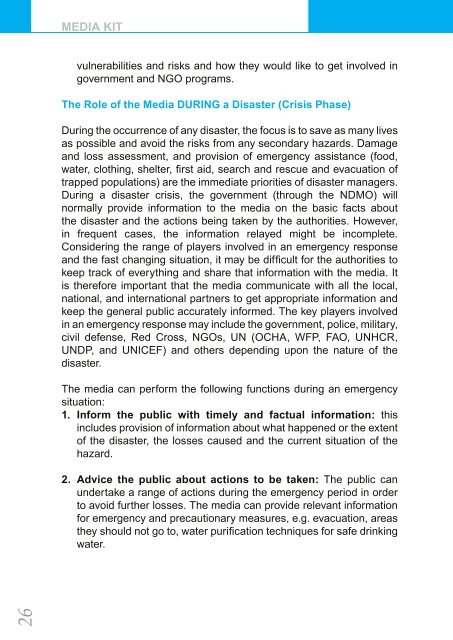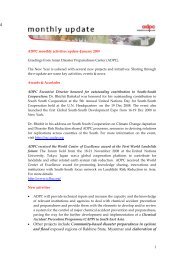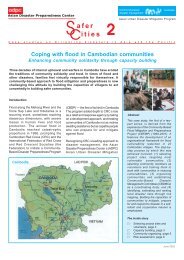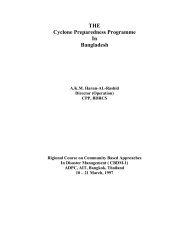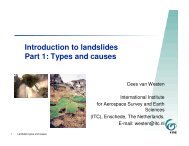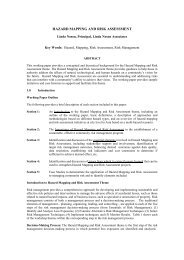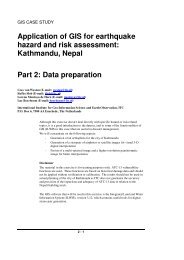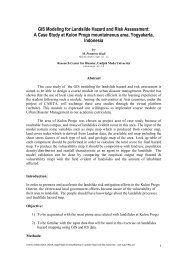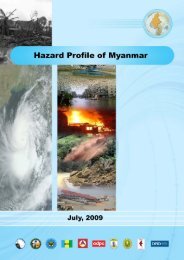community-based disaster risk management and the media media kit
community-based disaster risk management and the media media kit
community-based disaster risk management and the media media kit
You also want an ePaper? Increase the reach of your titles
YUMPU automatically turns print PDFs into web optimized ePapers that Google loves.
26<br />
MEDIA KIT<br />
vulnerabilities <strong>and</strong> <strong>risk</strong>s <strong>and</strong> how <strong>the</strong>y would like to get involved in<br />
government <strong>and</strong> NGO programs.<br />
The Role of <strong>the</strong> Media DURING a Disaster (Crisis Phase)<br />
During <strong>the</strong> occurrence of any <strong>disaster</strong>, <strong>the</strong> focus is to save as many lives<br />
as possible <strong>and</strong> avoid <strong>the</strong> <strong>risk</strong>s from any secondary hazards. Damage<br />
<strong>and</strong> loss assessment, <strong>and</strong> provision of emergency assistance (food,<br />
water, clothing, shelter, fi rst aid, search <strong>and</strong> rescue <strong>and</strong> evacuation of<br />
trapped populations) are <strong>the</strong> im<strong>media</strong>te priorities of <strong>disaster</strong> managers.<br />
During a <strong>disaster</strong> crisis, <strong>the</strong> government (through <strong>the</strong> NDMO) will<br />
normally provide information to <strong>the</strong> <strong>media</strong> on <strong>the</strong> basic facts about<br />
<strong>the</strong> <strong>disaster</strong> <strong>and</strong> <strong>the</strong> actions being taken by <strong>the</strong> authorities. However,<br />
in frequent cases, <strong>the</strong> information relayed might be incomplete.<br />
Considering <strong>the</strong> range of players involved in an emergency response<br />
<strong>and</strong> <strong>the</strong> fast changing situation, it may be diffi cult for <strong>the</strong> authorities to<br />
keep track of everything <strong>and</strong> share that information with <strong>the</strong> <strong>media</strong>. It<br />
is <strong>the</strong>refore important that <strong>the</strong> <strong>media</strong> communicate with all <strong>the</strong> local,<br />
national, <strong>and</strong> international partners to get appropriate information <strong>and</strong><br />
keep <strong>the</strong> general public accurately informed. The key players involved<br />
in an emergency response may include <strong>the</strong> government, police, military,<br />
civil defense, Red Cross, NGOs, UN (OCHA, WFP, FAO, UNHCR,<br />
UNDP, <strong>and</strong> UNICEF) <strong>and</strong> o<strong>the</strong>rs depending upon <strong>the</strong> nature of <strong>the</strong><br />
<strong>disaster</strong>.<br />
The <strong>media</strong> can perform <strong>the</strong> following functions during an emergency<br />
situation:<br />
1. Inform <strong>the</strong> public with timely <strong>and</strong> factual information: this<br />
includes provision of information about what happened or <strong>the</strong> extent<br />
of <strong>the</strong> <strong>disaster</strong>, <strong>the</strong> losses caused <strong>and</strong> <strong>the</strong> current situation of <strong>the</strong><br />
hazard.<br />
2. Advice <strong>the</strong> public about actions to be taken: The public can<br />
undertake a range of actions during <strong>the</strong> emergency period in order<br />
to avoid fur<strong>the</strong>r losses. The <strong>media</strong> can provide relevant information<br />
for emergency <strong>and</strong> precautionary measures, e.g. evacuation, areas<br />
<strong>the</strong>y should not go to, water purifi cation techniques for safe drinking<br />
water.


